Wild Horses: Legislation and the McCullough Peaks Herd
July 19, 2009Wild Horses – McCullough Peaks Herd soon to be rounded up
August 23, 2009Wild Horses of the Pryor Mountains
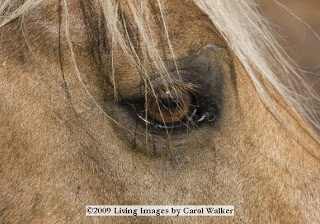
A week and a half ago I travelled once again up to the Pryor Mountains. A sense of urgency gripped me this year with the threat of the impending round up at the end of August looming large. How many of these horses would I never see again, how many would never see their families again?
So I headed up Crooked Creek Road, my favorite route to the top of the mountain, at 3:30 am so that I would reach the top of the mountain where the horses are just before dawn. I am one of those morning people, and for me the “magic hour” of photography with the most beautiful light is not the hour before sunset, but the half hour before to the half hour after dawn. Luckily I know the road well as I am driving in the dark. Just before I reach the top of the mountain, I see eyes flash in my headlights, and I brake suddenly, realizing this is a mountain lion, standing in the middle of the road. I am struck immediately by the sheer size of this beautiful animal. He (or she) saunters off slowly, unalarmed by my presence, and now I have first hand evidence of the reason many of the foals I was captivated by on my last trip are no longer on the mountain.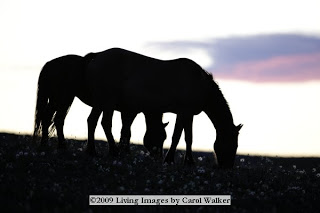
I continue on and see my first band of wild horses just as the sun is coloring the sky. It is Lakota’s band, and I am sad to see that the little newborn red colt Jethro I had seen on my last trip was missing from the band.
I continue on the road to the horse range, and am delighted to see that many of the horses are in one area. I walk down the hill and watch the foals play. I am happy to see that Madonna has a beautiful new filly this year who looks just hours old. She spends quite a bit of time napping in the flowers.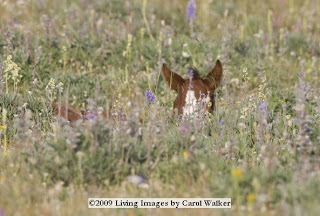
It’s summer, and the grass is lush, the temperature is mild, and it is a great day to be free in the Pryor Mountains.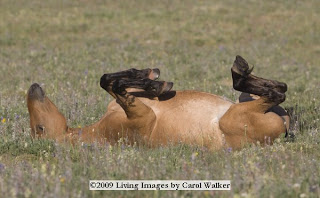
I am always delighted when people ask me how Cloud is – delighted to tell them that he is doing great, at 14 years old in the prime of his life, and always a wonderful photography subject.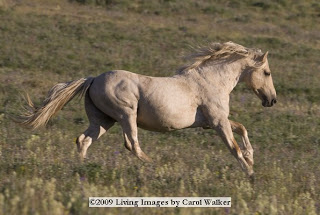
Soon I realize that Bolder’s band is starting to move downhill with a purpose. Since one of the main waterholes near Penn’s Cabin is just over the hill, this means that they are probably headed to water. I get in my car and head down the hill so I can set up my camera at a good spot for watching the bands come down to water.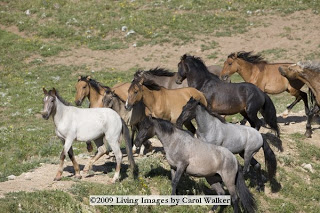
Bolder’s band come first, and I get to watch a very good example of heirarchy among the bands. The more senior, dominant band stallions have priority and get to stay as long at the waterhole as they like. Then, the next dominant, then on down usually with the bachelor stallions drinking last. Morningstar came down too soon for Bolder, however, and Bolder chased Morningstar and his entire band away from the water.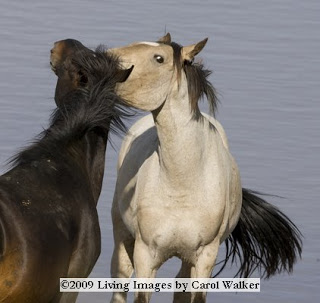
I did enjoy watching bands interact peacefully a little later when Diamond’s band came down to water. Diamond’s two year old colt came over to Morningstar and they played together for a little while, while Diamond’s yearling colt played with Bolder!
Soon all the bands had finished drinking and moved down into this deep canyon, which would be hard to follow, so I pack up my gear. As I drive back down the mountain, I think about the coming round up, and how nothing here will ever be the same. How much better to allow the mountain lions to naturally keep the population in check, than to put the horses at incredible stress to them through a roundup, over 70 horses to lose their freedom and their families forever.
You can make comments on the EA for the roundup of the Pryor Mountain Herd by August 17. Here is a link to the Cloud Foundation information for commenting and also for contacting Secretary of the Interior Ken Salazar’s office.
http://tinyurl.com/m5dfnf

2 Comments
I so agree with you about the mountain lions, as much I hate to see the foals killed. And as the Cloud Foundation says, they can't guarantee Cloud won't be rounded up. We all need to send our comments and speak up. Why do they keep on rounding up horses and building more holding areas when they say they can't afford to feed the ones they already have?
Wild means free. To trap any wild animal causes stress. You can see it in the trembleing of the muscles. When put in an unfamilar enviroment. Yes these horses can be tamed. Yet they do have a mind and as I saw with your adopted blue roan. He knew the herd when you rode him back to the Pryors. People have always thought they know what's best when nature is concerned. But look at the damage they have done. Nature has her way of check and balance. It has worked since the beginning of time. So let us let nature take her corse and enjoy what she sees fit for us to enjoy. T.T. Kentucky